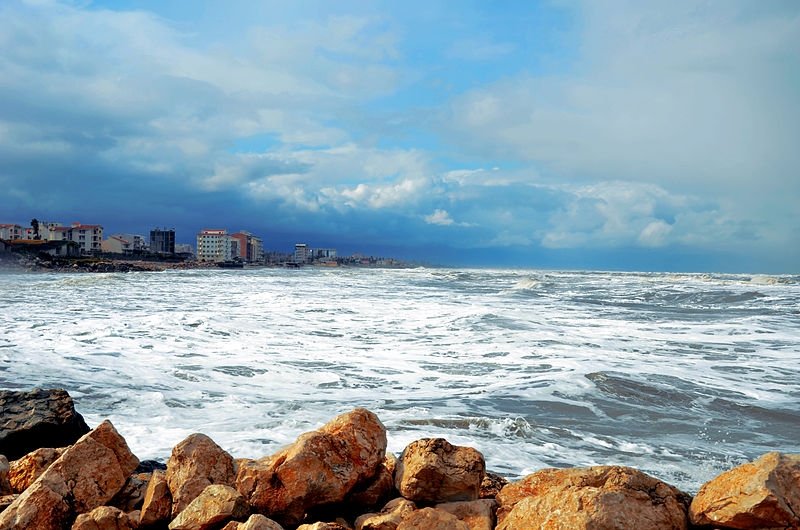By: Tejeshwar Singh Rana, Chief Officer-Merchant Navy & Associate Editor-ICN
The Caspian Sea lies in Eastern Europe, at the border between Europe and Asia. As the largest inland water body on Earth, it has been vital to the economy of the surrounding regions.
With a wealth of marine flora and fauna, the Caspian Sea covers nearly 0.4 million square kilometres of area and has an average depth of over 1 kilometre. It spans 7,000 kilometres of coastline covering 5 different nations on both continents.
Numerous islands dot the Caspian’s surface, and the Sea is 28 m below the mean sea level. The Caspian is considered to be an endorheic basin i.e., it has no primary outflow and retains water.
The primary means of water loss is through the water cycle (evaporation and other natural phenomena) and certain sub-surface geological rifts and depressions. The rivers that provide this inflow to the Caspian Sea are the Volga, the Ural, the Kura, and the Terek.
10 Interesting Facts About the Caspian Sea
In this article, we look at 10 interesting facts on the Caspian Sea. It has immense historical and geographical significance and is considered a major source of energy for the surrounding nations.
1-The Caspian Sea has a long history and many derivations of its name
A long-standing theory behind the name “Caspian” is that it refers to the Caspi people in the 6th century BC, who were native inhabitants of the region. They lived to the South West and were of Irani or Persian descent.
While not much literature exists on their exact culture, they have been mentioned in Egyptian, Persian, and Greek chronicles. The region they inhabited was known as Transcaucasia and was at the junction between Europe and Asia. This translates to modern-day Georgia, Armenia, and Azerbaijan.
The region of Iran has also greatly contributed to the lore and history of the Caspian Sea region. The fabled “Gates of Alexander” or “Caspian Gates” were barriers said to have been erected by the Macedonian conqueror- Alexander the Great, to keep barbarians from invading the territory to the South. It is supposed to lie in modern-day Tehran.
Interestingly, the Iranian city- Qazvin, is said to be the original regional name for the Caspian Sea. The water body was recorded as the “Bahr Qazvin” in antiquity by local Arabs. This translates to the “Sea of Qazvin” which was corrupted to Caspian later on.
In all neighbouring regions, the local name for the Caspian Sea stemmed from the common root. For instance:
2-The Caspian Sea is the world’s largest inland water body
The Caspian covers 371,000 square kilometres and is considered to be the largest inland lake owing to its sheer proportions. It is very large owing to the inflow from several major rivers and has an average elevation of 28 m below the mean sea level.
Interestingly, the Caspian Sea has not historically been very large, or even an inland land-locked lake. Until 11 million years ago, the Caspian Sea was connected to neighbouring water bodies such as the Black Sea and the Mediterranean Sea.
The connecting body of water was known as the Sea of Azov, and linked it to the “World Ocean”. The concept of the world ocean is that all water bodies on Earth are interlinked by lakes, straits, rivers, etc.
Today, the Caspian Sea is relatively isolated and is only linked via the inflow rivers. With minimal outflow regions, the Sea has become the largest inland water body.
3-The seabed is the 2nd lowest natural relief depression on Earth
The seabed of the Caspian Sea is varied in depth and sub-surface features. The depth of the Sea increases as one moves South. The North Caspian region covers an area of just less than 100,000 square kilometres and has an average depth of around 10 meters, with a maximum depth of 20 meters.
However, the South is considerably deeper with an average depth of over 1,000 meters. A region of 1,023 meters depth in the South is what makes the Caspian Sea the 2nd lowest natural relief depression. The first is Lake Baikal in Southern Siberia, which has a depth of 1,180 meters.
The seabed of the Caspian is generally flat in the North. Certain rapid elevations have formed the base for the islands in the Sea. Further towards the middle of the Sea lies the Mangyshlak Bank of the Middle Caspian spanning over 137,000 square kilometres.
This Bank has uneven depressions and the mean depth is over 200 meters. Further South lies the Abseron Bank that marks the Southern Caspian. It spans 149,000 square kilometres and has a deep depression with an average depth of 500 meters, and a maximum depth of 1,023 kilometres.
4-The seabed of the Caspian Sea holds clues to plate tectonics and geological phenomena
The Caspian Sea was originally above land to about 11 million years ago. As it submerged, the changing geology was also evident in the rocks of the region. This has helped scientists to understand plate tectonics and advanced geological phenomena.
The North Caspian region dates back to over 500 million years in the Precambrian era. It is part of the Russian Platform down warp formation. The Mangyshlak Bank is part of an ancient sub-surface movement that created the Hercynian mountains over 300 million years ago.
Due to the vast size of these continental plates, a depression was created in the middle nearly 250 million years ago, creating the Southern Caspian. The Abseron Bank was directly related to the Alpine process from 25 million years ago. This process resulted in the creation of the Caucasus mountain range.As per geological studies in the region, the Southern parts of the seabed continue to shift due to tectonic activity. A very interesting fact is that the Caspian Sea was connected to the Black Sea by a submarine feature known as the Kuma-Manych Depression. This was a connecting subterranean waterbody that existed till around 14 million years ago. Thereafter, a tectonic lift resulted in this depression closing. Today, the Caspian is almost entirely landlocked.
5-It is home to several unique species of marine fauna
As an inland lake, the Caspian Sea is home to numerous species of indigenous marine flora and fauna. Most of these are protected species to prevent ecological damage.Through archaeological surveys, researchers have identified possible evidence of dolphins, porpoises, and whales in the Sea around 50,000 – 100,000 years ago.
There have also been cave and rock arts dating to the same period indicating reliefs of dolphins and whales. These ancestors to the modern-day species were considerably larger.
Due to internal currents, species from the Caspian often reach other water bodies where they quickly become invasive. One such example is the Zebra mussel from the Caspian-Black region that has now spread to nearby coasts.On the other hand, numerous species have slowly been driven to extinction or endangerment owing to hunting. The Caspian seal, native to the region, numbers only around 100,000 today, when there were originally over 1 million in the early 1900s.
Some species unique to the Sea have been prefixed with the term “Caspian” to indicate their origin. This includes the Caspian tern, Caspian gull, Caspian turtle, and the aforementioned Caspian seal.
TO BE CONTINUED…




